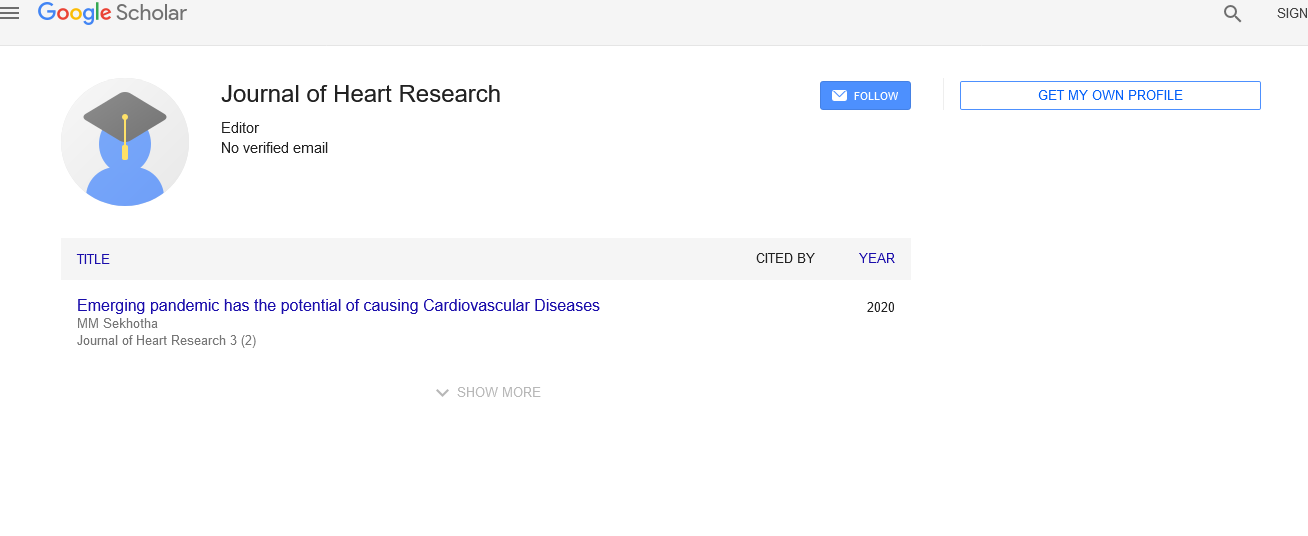Pulmonary vasodilators in LVAD patients
Received: 09-Apr-2022, Manuscript No. puljhr-22-4471; Editor assigned: 12-Apr-2022, Pre QC No. puljhr-22-4471 (PQ); Accepted Date: Apr 12, 2022; Reviewed: 21-Apr-2022 QC No. puljhr-22-4471 (Q); Revised: 24-Apr-2022, Manuscript No. puljhr-22-4471 (R); Published: 30-Apr-2022, DOI: 10.37532/puljhr.22.5(2).19-20
Citation: Jhones S. Pulmonary vasodilators in LVAD patients. J Heart Res. 2022; 5(2):19-20.
This open-access article is distributed under the terms of the Creative Commons Attribution Non-Commercial License (CC BY-NC) (http://creativecommons.org/licenses/by-nc/4.0/), which permits reuse, distribution and reproduction of the article, provided that the original work is properly cited and the reuse is restricted to noncommercial purposes. For commercial reuse, contact reprints@pulsus.com
Abstract
In individuals with end-stage left heart failure, a left ventricular assist device can save their lives. The pulmonary arterial pressure, wedge pressure, and pulmonary vascular resistances all fall as a result. Despite sufficient LV unloading, post capillary pulmonary hypertension remains in a considerable proportion of individuals. The pulmonary venous congestion and accompanying drop in nitric oxide levels could be one explanation. This finding has heightened interest in pulmonary vasodilators, particularly Phosphodiesterase 5 inhibitors (PD-5 I). They improve Nitric Oxide (NO) signaling by increasing the availability of cyclic guanosine monophosphate. Sildenafil has been shown to significantly reduce mPAP and PVR 2-4 weeks following LVAD installation and to wean from inotropic support within the first 72 hours, allowing the patient to be successfully intubated. However, while the research appears to support its usage in the early postoperative period, there are insufficient data on its long-term effectiveness.
Keywords
Pulmonary vasodilators; Patients; Dysfunction
Introduction
Individuals with end-stage left heart disease, a Left Ventricular Assist Device (LVAD) can save their lives. It can be a path to recovery, a path to a heart transplant, or a path to a destination therapy. In any of these circumstances, Right Ventricular Failure (RVF) can have a significant impact on clinical outcomes and a patient's candidacy for a heart transplant. The incidence of RVF following continuous-flow LVADs is 20% to 40%, with a mortality rate of 40% to 50%. RVF after LVAD implantation has been defined by the Interagency Registry for Mechanically Assisted Circulatory Support (INTERMACS). This includes signs and symptoms of Right Ventricle (RV) dysfunction (CVP>18 mm Hg and Cardiac Index (CI) 2.0 L/min/m2), Pulmonary Capillary Wedge Pressure (PCWP)>18 mm Hg, need for an RV Assist Device (RVAD), need for inhaled Nitric Oxide (iNO), or need for prolonged-duration inotropic support. The initially enhanced venous returns to the RV, the leftward displacement of the interventricular septum, and atrial and ventricular arrhythmias, which may occur in around 20% of patients, are all possible reasons for RVF after LVAD implantation. Excessive perioperative fluid challenge may also cause RV dilation. Pulmonary Hypertension in LVAD Patients
Due to decongestion of the pulmonary circulation, mechanical unloading of the Left Ventricle (LV) lowers Pulmonary Arterial Pressure (PAP), Pulmonary Capillary Wedge Pressure (PCWP), and Pulmonary Vascular Resistance (PVR). Despite sufficient LV unloading, pulmonary hypertension (PH) remains in a considerable proportion of patients following LVAD placement. A post capillary pH is defined as a mean PAP (mPAP) of less than 25 mmHg in the context of an unusually increased PCWP of more than 15 mmHg and normal or reduced Cardiac Output (CO). According to current rules, it is classed as Group 2 PH. PVR and Trans Pulmonary Pressure Gradient (TPG) are high in this subgroup of patients with pH type 2, which are features of Group 1 precapillary pH. A probable explanation is pulmonary venous congestion, which leads to a decrease in nitric oxide levels, as well as an increase in endothelin expression, which leads to pulmonary vasoconstriction and vascular remodeling. This finding sparked a surge in interest in pulmonary vasodilators, particularly Phosphodiesterase 5 inhibitors (PD-5 I), as a way to combat the negative pulmonary vascular remodeling and avoid RVF after an LVAD.
Phosphodiesterase-5 Inhibitors(Pde5i)and LVAD
PDE5i are pulmonary vasodilators that are commonly utilized in LVAD patients to unload the RV. However, there is currently a scarcity of supportive research with large sample sizes. Oral PDE5 inhibitors (sildenafil and tadalafil) are already used to treat Group 1 pH, either alone or in conjunction with other pulmonary vasodilators (endothelin receptor antagonists, PDE3i, and prostanoids). They raise the amounts of Cyclic Guanosine Monophosphate (cGMP), which enhances Nitric Oxide (NO) signaling. After LVAD surgery, INO is the initial step in preventing and treating RVF. The necessity for mechanical ventilation, on the other hand, may have an impact on RV performance. Furthermore, after discontinuing PAPs, there may be a rebound effect. Sildenafil enables the patient to be successfully intubated while titrating down the iNO. Sildenafil has been demonstrated to lower mPAP and PVR in the first 72 hours following LVAD implantation and to wean patients off inotropic assistance. However, no significant variations in PCWP or CO were identified between the sildenafil and control groups. Despite the possibility of dizziness, nausea, and systemic hypotension, there has been no substantial increase in gastrointestinal bleeding or stroke. Given the possibility of platelet inhibition with PDE5i, this is intriguing.
Conclusion
The benefits of sildenafil treatment in critically ill patients with RV dysfunction are widely known. However, observational small sample size studies dominate the literature, limiting the power to achieve statistically meaningful results. Furthermore, no predetermined algorithm exists to guide sildenafil use following LVAD implantation. Patients with pre- and post-capillary pH, as well as substantial RV dysfunction, would be the best candidates for this treatment. Other pulmonary vasodilators are also being studied for their indications and efficacy. The prospective, randomized clinical trial SOPRANO (regarding the effect of Macitentan in patients with PH after LVAD implantation) is under underway, and it could help researchers better understand the role of pulmonary vasodilators in LVAD patients. These findings could pave the way for more research into the role of PDE5i in protecting RV function in individuals with severe heart failure or those at high risk of developing RVF.





